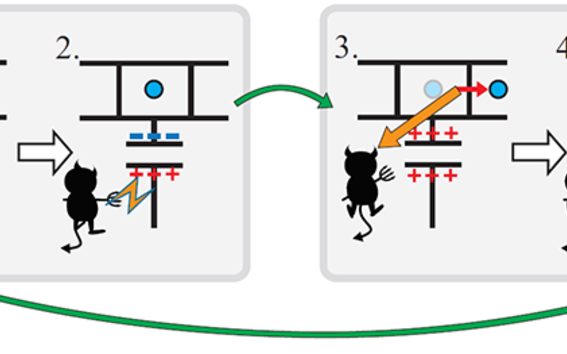Maxwell’s demon as a self-contained, information-powered refrigerator

An autonomous Maxwell's demon. When the demon sees the electron enter the island (1.), it traps the electron with a positive charge (2.). When the electron leaves the island (3.), the demon switches back a negative charge (4.). Image: Jonne Koski.
In 1867, Scottish physicist James Clerk Maxwell challenged the second law of thermodynamics according to which entropy in a closed system must always increase. In his thought experiment, Maxwell took a closed gas container, divided it into two parts with an inner wall and provided the wall with a small trap door. By opening and closing the door, the creature – ‘demon’ – controlling it could separate slow cold and fast warm particles to their respective sides, thus creating a temperature difference in contravention of the laws of thermodynamics.
On theoretical level, the thought experiment has been an object of consideration for nearly 150 years, but testing it experimentally has been impossible until the last few years. Making use of nanotechnology, scientists from Aalto University have now succeeded in constructing an autonomous Maxwell’s demon that makes it possible to analyse the microscopic changes in thermodynamics. The research results were recently published in Physical Review Letters. The work is part of the forthcoming PhD thesis of MSc Jonne Koski at Aalto University.
‘The system we constructed is a single-electron transistor that is formed by a small metallic island connected to two leads by tunnel junctions made of superconducting materials. The demon connected to the system is also a single-electron transistor that monitors the movement of electrons in the system. When an electron tunnels to the island, the demon traps it with a positive charge. Conversely, when an electron leaves the island, the demon repels it with a negative charge and forces it to move uphill contrary to its potential, which lowers the temperature of the system,’ explains Professor Jukka Pekola.
What makes the demon autonomous or self-contained is that it performs the measurement and feedback operation without outside help. Changes in temperature are indicative of correlation between the demon and the system, or, in simple terms, of how much the demon ‘knows’ about the system. According to Pekola, the research would not have been possible without the Low Temperature Laboratory conditions.
We work at extremely low temperatures, so the system is so well isolated that it is possible to register extremely small temperature changes.
‘We work at extremely low temperatures, so the system is so well isolated that it is possible to register extremely small temperature changes,’ he says.
‘An electronic demon also enables a very large number of repetitions of the measurement and feedback operation in a very short time, whereas those who, elsewhere in the world, used molecules to construct their demons had to contend with not more than a few hundred repetitions.’
The work of the team led by Pekola remains, for the time being, basic research, but in the future, the results obtained may, among other things, pave the way towards reversible computing.
‘As we work with superconducting circuits, it is also possible for us to create qubits of quantum computers. Next, we would like to examine these same phenomena on the quantum level,’ Pekola reveals.
J. V. Koski, A. Kutvonen, I. M. Khaymovich, T. Ala-Nissilä and J. P. Pekola: On-chip Maxwell’s demon as an information-powered refrigerator.
The abstract of the article can be read at http://journals.aps.org/prl/abstract/10.1103/PhysRevLett.115.260602
Check also Sebastian Deffner’s Viewpoint: Exorcising Maxwell’s Demon at http://physics.aps.org/articles/v8/127
More information:
Academy Professor Jukka Pekola
Tel. +358 40 700 9290
[email protected]
See also, how Maxwell’s demon converts information to energy with the help of nanotechnology.
- Published:
- Updated:
Read more news

Aalto ARTS alum Vidha Samya’s artwork featured at the Venice Biennale 2024
The Pavilion of Finland presents ‘The pleasures we choose’ at the 60th International Art Exhibition – La Biennale di Venezia until 24 November 2024.
IoT Forge donates EUR 1 million to the School of Engineering
The donation will be used for research and education on the Industrial Internet and digital twins.
Join us for the first Aalto Open Science Award Ceremony
All Aaltonians are welcome – no registration required!